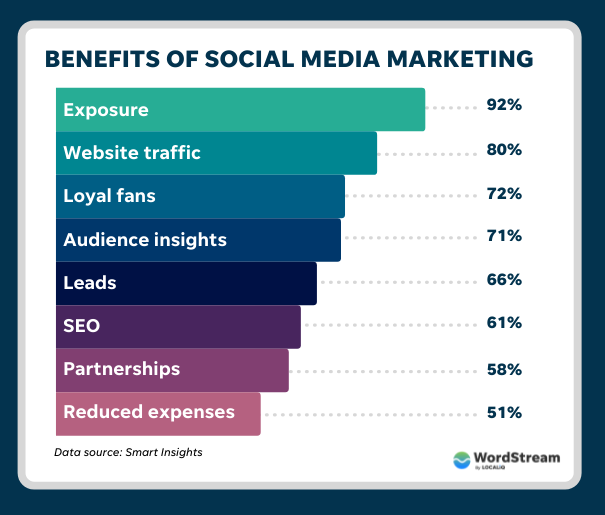
Social networks
Social networks are one of the pillar channels of digital marketing, but what differentiates them from other pillars, such as search engines and email, is that they have many platforms within them. And not in the Bing vs Google style. Every platform has massive audiences that are ready for advertising.

Social media advertising is not necessarily the same as social media targeting. Media targeting optimizes social media advertising by using profile data to deliver ads directly to individual users. Social media advertising refers to matching social media users with target groups specified by the advertiser. Media advertising involves creating content on social media platforms, interacting with followers, and posting ads on social media.
Types of Social Media Advertising:
- Image Ads. These are perhaps the most common types of social media ads.
- Video Ads. Video is a powerful marketing tool.
- Carousel Ads
- Stories Ads.
- Message Ads.
- Collection Ads.
Benefits of Social Media Advertising:
As with any PPC strategy, social media advertising has many benefits for businesses. Here are some reasons to advertise on social media:
- Cost-effective: PPC generally produces an average return on investment of 200%. Plus, so paid social media is a lower-cost alternative to targeting your competitors’ audiences in search.
- Brand Awareness: Not only is social media extensive, but visual ads allow you to customize them to your brand and style.
- Engagement: In addition to ad clicks, users can interact with social media ads by liking, sharing, and commenting.

- Formats: As mentioned above, social media ads support a wide range of formats and media types.
- Targeting: Because users share detailed information about themselves on platforms, social media ads allow for granular targeting.
- Non-disruptive: For the most part, social media ads are typically difficult to distinguish from organic posts on the platforms, making them a less disruptive way to reach your audience.
Social Media Advertising channels:
- TikTok
- YouTube
- Snapchat
- YouTube advertising
- Twitter live

How does social media advertising work?
When it comes to social media advertising, four components reign supreme: goals and objectives, target audience, ad creatives, bids, and budgets. These components are the building blocks of any successful campaign, allowing you to connect with the right audience, create compelling social media messages, and manage your budget effectively.
By leveraging multiple data sources, advertisers can hyper-target their audiences and deliver personalized content based on user demographics and behavior. These campaigns reach specific people based on their interests, demographics, and behavior. Through ads, brands can send specific promotions to both potential customers and past customers.
Strategy of Social Media Advertising:
Planning and publishing:
Social networks are an important step. It can be as simple as planning and posting a tweet on Twitter. Before companies launch social media advertising campaigns, they should consider and plan for a few elements. This includes considering your target audience and allowing a brand to advertise more effectively.
Listening and commitment:
It is important to observe the comments, tags and hashtags in which the target audience participates. How people connect with your social media accounts and content is measured by social media engagement. The phrase can refer to a wide range of behaviors on all social media sites. Engagement may involve actions such as likes, favorites, comments, direct messages, replies, shares, retweets, saves, clicks, or mentions.
Analytics:
consisting of knowing how marketing on social networks is working. For example, this will be the number of people reached on your social media platform or how many mentions the brand got during the month. Business accounts allow brands to track and analyze their analytics. Social media advertising acts as a tracking tool that provides quantifiable measures, such as the number of likes, shares, comments, opens, views, followers or clicks, as engagement indicators.
Advertising:
Online advertising, also known as online marketing, Internet advertising, digital advertising or web advertising, is a form of marketing and advertising that uses the Internet to promote products and services to audiences and platform users.Online advertising includes email marketing, search engine marketing (SEM), social media marketing, many types of display advertising (including web banner advertising), and mobile advertising. Advertisements are increasingly delivered through automated software systems that operate across multiple websites, media services and platforms, known as programmatic advertising.
.png?width=600&height=300&name=Pillars%20of%20Social%20Media%20Marketing%20(2).png)
Problems and Solution:
common social media advertising problems are:
- Not engaging with followers.
- Focusing too much on sales.
- Being tone-deaf to your audience and platform-specific trends.
- Building strategy based on instinct instead of performance.
Solution of social media advertising problems:
- Be mindful of your social media habits.
- Set limits on the amount of time you spend on social media.
- Know when it’s time to stop scrolling.
- Use social media to connect with people who inspire you, share similar interests, and provide a sense of belonging.
References:
https://www.wordstream.com/blog/ws/2022/07/18/social-media-advertising
Leave a Reply